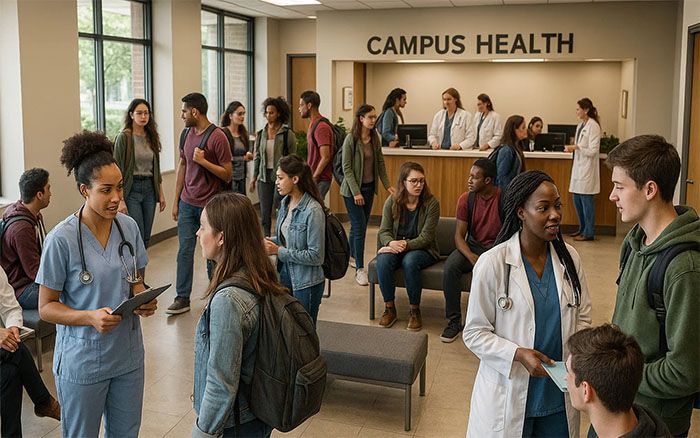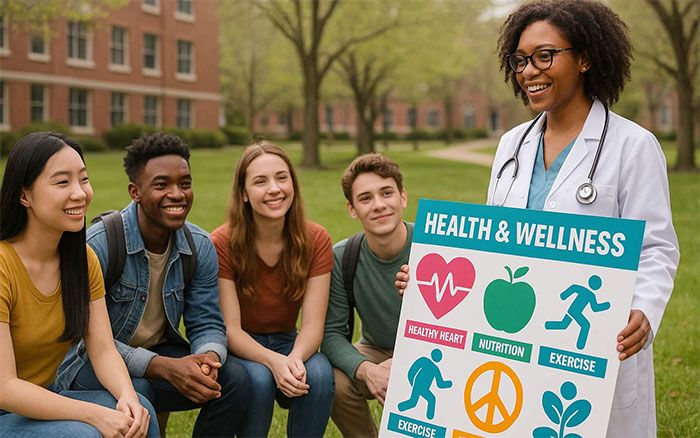Rethinking “Wellness”:
How to Drive Collective Impact, Collaborate Better, and Leverage Data to Transform Your Campus
Webinar Q&A recap with college well-being experts Dr. Oliver Tacto from Maryville University, Emily Pagano from UConn, and Kelly Gorman from UAlbany to share their expertise on enhancing student well-being.
During the webinar, we covered the following key topics:
- What does it mean to truly collaborate? And what are the biggest roadblocks getting in the way of meaningful progress?
- What steps can you take to effectively implement your most ambitious well-being ideas and initiatives?
- What is the Okanagan Charter and why should you know about it?
- What tools and infrastructure need to be in place before you start to enact change?
- How can campus leaders develop Key Performance Indicators (KPIs) to better measure campus well-being?
Q1: Wellness and well-being are terms we hear often. Are they the same thing, or is there a difference?
Oliver: Wellness involves actions and habits that support physical, mental, and emotional health. It’s the journey. Well-being is the outcome—a balanced, fulfilled state that results from those wellness practices.
Kelly: I think of wellness as more of an individual construct, while well-being is broader, encompassing personal, communal, and societal levels.
Emily: It’s less about whether this is the “right” definition and more about how we use this term and what it means for us and the community that’s coming together to do this work. This understanding connects to our goals and what we’re trying to measure.
Q2: What are “inputs” in college well-being and what are some examples of inputs that can lead to improved well-being on campus?
Oliver: When we talk about inputs, we’re really talking about what people and resources we’re putting in when we say we’re “investing” in well-being. Inputs can vary widely depending on a campus’s unique environment. Here are a few examples:
- Counseling and Support Staff: Access to mental health counselors and support staff is fundamental.
- Health Services: Offering accessible health care and support for students’ physical wellness is a vital input.
- Financial Resources: Some institutions have larger budgets to support well-being initiatives, which can make a significant difference.
- Campus Environment: This includes everything from the built environment (like dorms, classrooms, and administrative buildings) to resources that allow for outdoor activities and engagement. Some campuses offer more natural spaces, which can positively impact student wellness.
Essentially, assessing and utilizing these inputs allows campuses to build a stronger foundation for student, faculty, community, and staff well-being.
Emily: Creating alignment across those inputs is a huge part of engaging in health promotion. Often, we have amazing assets on campus, but they’re not aligned, aware of one another, or working towards the same goals.
Q3: What’s an overlooked asset when it comes to college wellness promotion?
Emily: Our University Planning colleagues have been invaluable allies, as they are deeply considering how the campus environment supports the experiences of students, staff, and faculty. Additionally, our partners in Sustainability, including those in facilities like wastewater management, play a critical role in this work.
Kelly: Two often-overlooked assets are relationships and student leadership. Successful environments combine top-down and bottom-up support, building connections across titles. Additionally, student leadership, including the Student Activities Office and Student Leadership Development, is essential.
Q4: What does the collaboration process look like? And how do you know when you’re collaborating versus cooperating?
Oliver: I view cooperation and collaboration as a choice between planning an event versus a shared vision. We must align our goals toward a common agenda and communicate consistently with stakeholders about this shared goal, ensuring resources are equitable. When collaboration fails, it can feel one-sided, focusing on individual departments instead of highlighting the entire university’s progress toward well-being.
Kelly: Collaboration involves drawing out the wisdom of others in the space. I ask questions to understand the motivations behind our work, the overarching goals, and the mission. For me, it means aligning on shared values, strategic priorities, and vision while committing to express those values healthily throughout our process.
P.S. 60% of our live webinar audience said they can cooperate but struggle to collaborate successfully with their colleagues.

Q5: What are some strategies for transitioning from cooperation to genuine collaboration?
Emily: I think the biggest barrier often lies in the structural designs within higher education institutions themselves, which are not always conducive to collaboration. For instance, a small but significant challenge we faced was faculty and staff using two separate communication systems (Google for faculty and Office 365 for staff). Even setting up meetings became difficult! So, my advice would be to assess your current structures, identify who’s already invested in these wellness goals, and then start building a strong base. Over time, establishing ongoing communication and even starting small projects together can lay the groundwork for a more extensive partnership.
Q6: What is the Okanagan Charter and why is it valuable for campus leaders to be aware of it?
Oliver: The Okanagan Charter is a foundational document established at an international conference for health-promoting professionals and universities. It provides a global framework for embedding health into all aspects of campus life—from operations and programming to culture and community.
The Charter promotes a holistic approach, ensuring campus-wide well-being through integrated initiatives. Rather than a checklist, it represents a commitment to cultivating a culture of health, signaling an institution’s readiness to make meaningful cultural and structural changes in support of health promotion.
Emily: The Charter’s emphasis on the interdependence of people, place, and planet has been instrumental in bringing together diverse partners from facilities, sustainability, campus planning, and research. We use it as a platform to discuss how our shared spaces and policies can promote health beyond individual departments.
The Charter gives us a language and framework to address well-being holistically, making it easier to collaborate on solutions that impact everyone.
Q7: How can university leaders set effective KPIs to measure campus wellness?
Kelly: At UAlbany, we’ve adopted the Okanagan Charter as our guiding framework, focusing on a systems approach to integrate well-being into all campus operations. Setting effective KPIs starts with agreement on a shared vision of well-being. We’re using realist evaluation to link KPIs to broader social processes, which helps measure complex outcomes beyond immediate results.
Emily: At UConn, we also adopted the Okanagan Charter and recently aligned our wellness KPIs with our new strategic plan. We emphasize relationship-building across departments to ensure equitable access to wellness initiatives. Our core KPIs focus on belonging, which resonates across wellness conversations, and sustainability metrics, as our university moves toward carbon neutrality.
Oliver: At Maryville, we’re developing KPIs using the eight dimensions of wellness framework. This approach helps us measure wellness comprehensively, covering areas like mental health access, active lifestyles, and student belonging. To engage students, we’ve implemented the “MaryWELL” initiative, which tracks their participation across wellness dimensions, from academic support to financial literacy. The framework guides measuring our progress across diverse aspects of campus wellness.
Key Takeaways
In this Q&A, we’ve highlighted key insights from our recent discussion on how campuses can go beyond the “wellness” buzzword to create lasting, measurable impacts on student well-being. We hope you found these expert insights valuable.
























